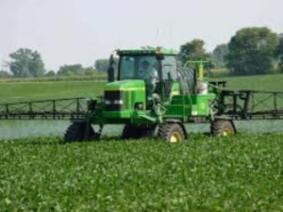by: Dr. Mark Loux, OSU Extension

It’s been a tough summer in parts of Ohio to do anything on a timely schedule and there are some weedy fields. The best advice we have for big weeds in full-season soybeans is to increase rates and the complexity of POST herbicide applications, while still adhering to cutoffs for the application of certain herbicides as much as possible. Dicamba products, XtendiMax, Engenia, and Tavium, cannot legally be applied to Xtend and XtendiFlex soybeans after June 30. This cutoff date pertains to use in double-crop soybeans also. If you are planning on planting Xtend or XtendiFlex soybeans in double-crop fields and using dicamba as a burndown, apply before Friday. There isn’t a cutoff date for most other POST soybean herbicides – it’s based on either crop stage (eg R1) or days before harvest.
Double crop soybeans usually need some type of weed control program, although how weedy they get depends upon weeds surviving down in the wheat that can take off once they receive light; how much rain we get in July, which drives additional weed emergence and rate of soybean growth; and how fast the soybeans grow and develop a canopy. Control can occur via the use of pre-plant/preemergence burndown herbicides, followed by POST as needed. It’s also possible to accomplish this with one early POST application in Enlist soybeans, using Enlist Duo or a combination of Enlist One with glyphosate or glufosinate. And also in LLGT27 soybeans with a combination of glyphosate and glufosinate. Herbicides need to address marestail in many fields, which is often lurking in the wheat ready to regrow. Marestail that are taller and get cut off by the combine will be more difficult to control than the smaller intact ones below the cutter bar. Herbicide options vary depending upon the weeds and what type of soybeans are planted. More effective options include:
- Glyphosate or glufosinate + Sharpen (1 oz) + MSO – any soybean, prior to emergence
- Glyphosate or glufosinate + 2,4-D – any soybean, at least a week before planting
- Enlist Duo; glyphosate or glufosinate + Enlist One (Enlist soybeans) – PRE or POST, no wait to plant
- Glyphosate + XtendiMax or Engenia (Xtend or XtendiFlex soybeans) – PRE, apply by June 30
- Glyphosate + glufosinate – PRE in any soybean, PRE or POST in LLGT27 soybean
It is possible to include residual herbicides with a PRE burndown treatment, but their value in this situation is questionable. Residual herbicides with long recrop intervals to corn should be avoided. POST options in double-crop include glufosinate, glyphosate, Enlist One/Duo, and conventional herbicides, depending upon the type of soybean planted. One caution here is to avoid excessive injury to soybeans that slows growth and development since this is likely to reduce yield due to the short season. Weed emergence is reduced and variable in July compared with May and June. Where burndown herbicides are used, but there is still a need for POST herbicides to control a flush of late-emerging weeds, consider reduced rates. Research we conducted back in the 1990s demonstrated that weeds up to 2 inches tall can usually be controlled with half of a typical labeled rate. When we planted soybeans in early June, the single application of a half-rate provided adequate control, versus early May when a second application was needed. So this should be a suitable approach for double-crop soybeans. Just be sure to start with an effective burndown at planting, and apply when weeds are well within the 2-inch size.
 After planting, the second biggest challenge we face is timely weed control. If you haven’t already made a postemergence application, it might be time to check your fields. Most beans (and weeds) are at stage that might warrant an application.
After planting, the second biggest challenge we face is timely weed control. If you haven’t already made a postemergence application, it might be time to check your fields. Most beans (and weeds) are at stage that might warrant an application.


 When determining your herbicide program for spring applications, the stage of the wheat crop should be considered. The majority of wheat herbicides labeled for application at certain wheat growth stages have very short windows in which they can be applied. The popular broadleaf weed herbicides 2,4-D and MCPA are efficient and economical, but can only be applied for a short period of time between tillering and prior to jointing in the early spring. Wheat growth stages and herbicide timing restriction are outlined in a in a post last week (
When determining your herbicide program for spring applications, the stage of the wheat crop should be considered. The majority of wheat herbicides labeled for application at certain wheat growth stages have very short windows in which they can be applied. The popular broadleaf weed herbicides 2,4-D and MCPA are efficient and economical, but can only be applied for a short period of time between tillering and prior to jointing in the early spring. Wheat growth stages and herbicide timing restriction are outlined in a in a post last week (






